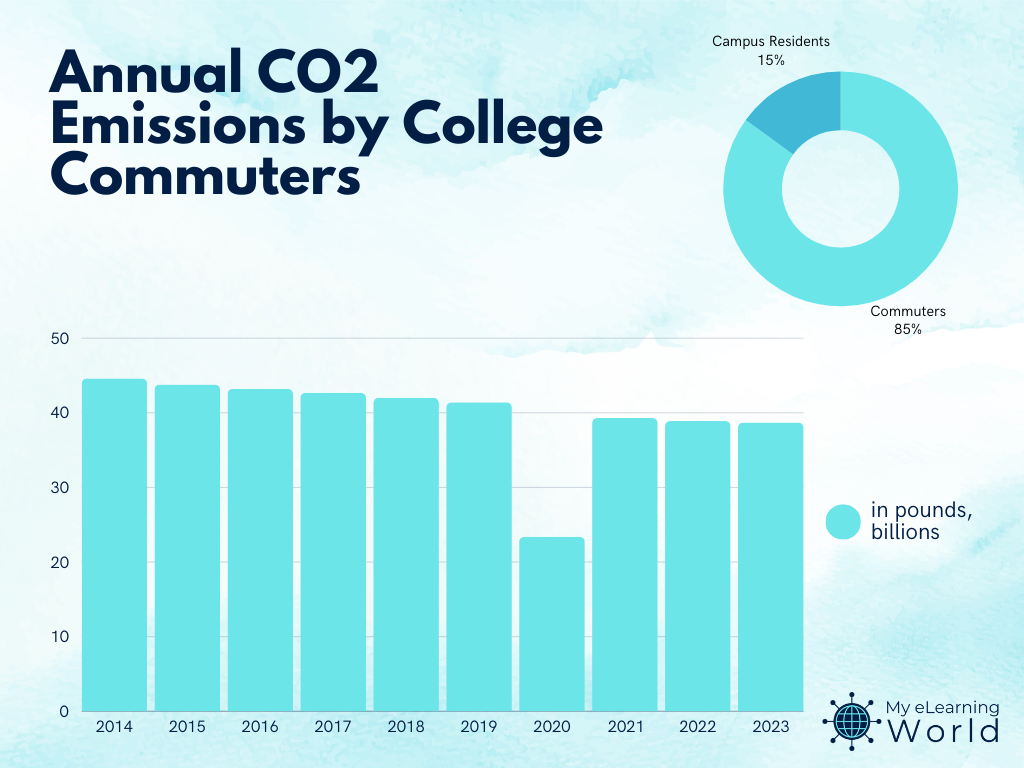Increasing Remote Learning in US Colleges Could Save Up to 34.8 Billion Pounds of CO2 Emissions Per Year
Commuter students have a big impact on the environment, but a switch to remote learning could yield huge benefits.

It’s no secret that transportation plays a significant role in environmental impact, particularly when it comes to workplace commuting. But another area of transportation that often gets overlooked despite its significant environmental impact is how college commuting patterns contribute notably to CO2 emissions. Personal vehicles, often the preferred mode of transport for the 85% of college students who commute to school, are more detrimental in terms of CO2 emissions per mile compared to public or shared transportation options.
We often overlook carbon emissions in our daily routines, pushing them to the back of our minds, but the environmental impact of greenhouse gases from our daily commutes, including those of college students, is substantial and cannot be ignored.
But what exactly is the extent of the damage caused by college commuting habits? Does the choice of each individual truly have a significant impact?
We did an in-depth study to calculate the full potential environment impact of college commuting, and found that student commuter emissions may have reached as high as 38.7 billion pounds of CO2 in 2023. Not only that, a switch to remote learning in US colleges could reduce emissions by 34.8 billion pounds per year.
By the Numbers
Let’s dive into how we arrived at these numbers.
As mentioned above, the latest data shows about 85% of college students commute to school. Not only that, the data shows that the average commuting student drives 10 miles each way to and from school.
The average college student will attend 30 weeks of school each year (15 each in the fall and spring) — that’s up to 150 days of commuting to and from school (note: while many students attend 5 days a week, some do attend 2-4 days weekly, depending on their schedule).
According to the EPA, the average passenger vehicle emits about 404 grams of CO2 per mile driven. That means a college student who attends classes 5 days a week emits about 1.2 metric tons (or 2,672 pounds) of CO2 every school year — that’s nearly 5 metric tons (about 10,688 pounds) of C02 from their vehicle during a 4-year stint driving to and from school.
Now, let’s expand that out to the entire college student population.
Our most recent estimates found that 17,026,478 attended college in 2023. If 85% of all college students are commuters, that means as many as 14,472,506 of them drive to school.
With that in mind, we can say that college commuters could have accounted for up to 38,670,527,927.4 pounds of greenhouse gas emissions from their vehicles going to and from school in 2023. That could result in 154.7 billion pounds of tailpipe emissions over a 4-year enrollment for this cohort.
Even if these students all only commuted to school 3 days a week, that would still represent 23.2 billion pounds of CO2 emissions this year.
Potential Environmental Impact of Expanded Remote Learning
We can’t help but imagine the potential reduction in carbon footprint if more students engaged in remote learning.
Expanding remote learning opportunities doesn’t just offer educational flexibility, it presents a substantial opportunity for environmental conservation. If a larger portion of the student population could shift to remote or hybrid models, the decrease in daily commutes could lead to a significant reduction in overall CO2 emissions. This change could play a significant role in combating climate change.
In fact, research conducted by the Stockholm Environmental Institute (SEI) has revealed that online learning has the potential to significantly lower CO2 emissions, by as much as 90%. In other words, a full switch to remote learning in US colleges could reduce emissions by 34.8 billion pounds per year.
This finding is echoed by a study in the UK, which observed an approximate 85% reduction in CO2 emissions among virtual learners compared to their full-time, on-campus counterparts. It’s also been noted that providing an online course to a group of 100 students could lead to a reduction of 5 to 7 tons in CO2 emissions.
Interestingly, awareness of these environmental benefits among students can also enhance their overall satisfaction with the course.
The adoption of remote learning could also reduce the need for extensive physical infrastructure on campuses, leading to lower energy consumption and further diminishing the environmental impact of higher education institutions.
By embracing and enhancing remote learning opportunities, colleges and universities could play a pivotal role in not only reshaping education but also in contributing to a more sustainable future.
This shift could mark a crucial step in our collective efforts to reduce our carbon footprint and protect our planet.



No Comment